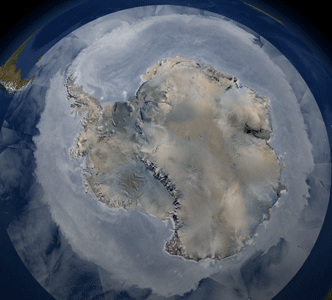A Tour of the Cryosphere: Earth's Frozen Assets
03.23.06

Even distance does not provide adequate perspective on all things. In terms of the cryosphere—the frozen stretches of the planet that act as the Earth’s thermostat--the best way to fully appreciate its importance is not only from orbiting observatories, but also through the data they collect.
That data forms the backbone of this extraordinary visual tour. In a little more than seven minutes, some of the best data visualizers at NASA’s Goddard Space Flight Center lead viewers across the icy reaches of Antarctica, the drifting expanse of polar sea ice, the shrinking cap around the North Pole, and more. The tour travels around the world in a single “shot”; there are no abrupt cuts or scene changes. The effect of this technique helps convey the interconnectedness of the cryosphere to the rest of the world, and also helps viewers feel that they are not so distant from the world’s snow and ice assets. The video also highlights the scientific importance of continued collection of this kind of data, and why NASA is uniquely qualified to study the Earth.
About This Video

NASA is pleased to offer two versions of this remarkable Tour of the
Cryosphere for download. The first presents narration with the video; the
second presents the video without narration, but uses a dramatic musical
score and on-screen annotations as you traverse the planet. You will find
versions of each video, plus related still images in multiple screen sizes
and resolutions at our main download site.
+ Visit our main download site
To receive a copy of the DVD contact
outreach@eos.nasa.gov .
NASA Scientist Claims Warmer Ocean Waters Reducing Ice Worldwide
Glaciers and ice sheets around the world have a big problem: warmer waters. Now, the pieces to a years-old scientific puzzle have come together to confirm warmer water temperatures are creeping into the Earth's colder areas. Those warm waters are increasing melting and accelerating ice flow in polar areas. No reversal of this warm water is in sight.
This conclusion appears in an article by Robert Bindschadler in the March 24 issue of Science magazine. Bindschadler is a Glaciologist at NASA's Goddard Space Flight Center (GSFC) in Greenbelt, Md.
+ Read more
+ Related images and video
Biographies
Bob Bindschadler

Dr. Robert Bindschadler is a Chief Scientist of the NASA's Hydrospheric and Biospheric Sciences Laboratory, a Senior Fellow of the Goddard Space Flight Center, a Fellow of the American Geophysical Union and a past President of the International Glaciological Society. He maintains an active interest in the dynamics of glaciers and ice sheets, primarily on Earth, investigating how remote sensing can be used to improve our understanding of the role of ice in the Earth's climate. He has published over 130 scientific papers, numerous review articles and has appeared on television, radio and is often quoted in print media commenting on glaciological impacts of the climate on the world's ice sheets and glaciers.
Waleed Abdalati

As head of the Cryospheric Sciences Branch at the NASA Goddard Space Flight
Center, Waleed Abdalati served as science advisor during the making of this
video. In addition to suggestions on scientific content, Dr. Abdalati
offered advice on how to access particular data sets, how to structure the
timing and perspective of certain animations, and reviewed script materials
and animation development for clarity and accuracy.
Dr. Abdalati received his Ph.D in Geography, Program for Atmosphere and
Ocean Sciences, from the University of Colorado in 1996. He came to Goddard
as a post-doc in 1996, and formally joined the agency in 1998. He became the
head of the Cryospheric Sciences branch in 2004.
Walt Meier

Walt Meier is a research scientist, specializing in the remote sensing
of sea ice, at the National Snow and Ice Data Center, part of the
University of Colorado's Cooperative Institute for Research in the
Environmental Sciences. He led the NSIDC contribution to the animation,
providing expertise on cryospheric processes and the datasets provided
by NSIDC. These datasets include the passive microwave sea ice imagery,
the MODIS snow cover product, and the tropical glacier and permafrost
fields.
Michael Starobin
NASA Goddard Space Flight Center